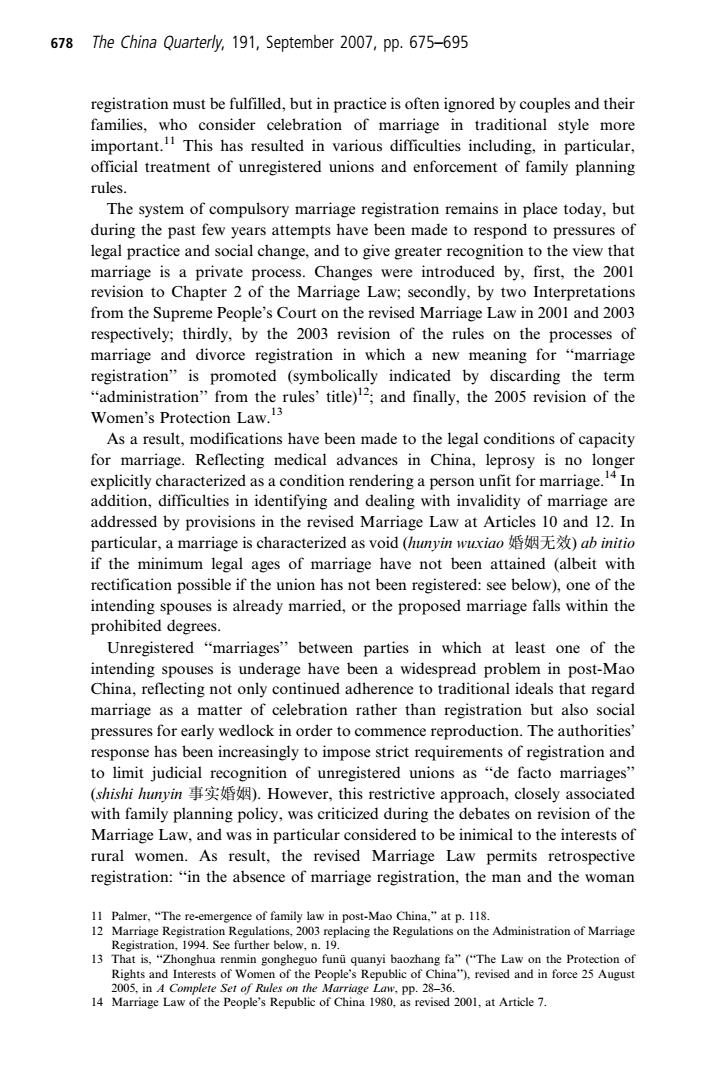正在加载图片...

678 The China Quarterly,191,September 2007,pp.675-695 registration must be fulfilled,but in practice is often ignored by couples and their families,who consider celebration of marriage in traditional style more important.This has resulted in various difficulties including,in particular, official treatment of unregistered unions and enforcement of family planning rules. The system of compulsory marriage registration remains in place today,but during the past few years attempts have been made to respond to pressures of legal practice and social change,and to give greater recognition to the view that marriage is a private process.Changes were introduced by,first,the 2001 revision to Chapter 2 of the Marriage Law;secondly,by two Interpretations from the Supreme People's Court on the revised Marriage Law in 2001 and 2003 respectively;thirdly,by the 2003 revision of the rules on the processes of marriage and divorce registration in which a new meaning for "marriage registration"is promoted (symbolically indicated by discarding the term "administration"from the rules'title);and finally,the 2005 revision of the Women's Protection Law.13 As a result,modifications have been made to the legal conditions of capacity for marriage.Reflecting medical advances in China,leprosy is no longer explicitly characterized as a condition rendering a person unfit for marriage.In addition,difficulties in identifying and dealing with invalidity of marriage are addressed by provisions in the revised Marriage Law at Articles 10 and 12.In particular,a marriage is characterized as void(hunyin wuxiao婚姻无效)ab initio if the minimum legal ages of marriage have not been attained (albeit with rectification possible if the union has not been registered:see below),one of the intending spouses is already married,or the proposed marriage falls within the prohibited degrees. Unregistered "marriages"between parties in which at least one of the intending spouses is underage have been a widespread problem in post-Mao China,reflecting not only continued adherence to traditional ideals that regard marriage as a matter of celebration rather than registration but also social pressures for early wedlock in order to commence reproduction.The authorities' response has been increasingly to impose strict requirements of registration and to limit judicial recognition of unregistered unions as "de facto marriages" (shishi hunyin事实婚姻).However,.this restrictive approach,closely associated with family planning policy,was criticized during the debates on revision of the Marriage Law,and was in particular considered to be inimical to the interests of rural women.As result,the revised Marriage Law permits retrospective registration:"in the absence of marriage registration,the man and the woman 11 Palmer,"The re-emergence of family law in post-Mao China,"at p.118. 12 Marriage Registration Regulations,2003 replacing the Regulations on the Administration of Marriage Registration,1994.See further below,n.19. 13 That is,"Zhonghua renmin gongheguo funui quanyi baozhang fa"("The Law on the Protection of Rights and Interests of Women of the People's Republic of China").revised and in force 25 August 2005.in A Complete Set of Rules on the Marriage Law,pp.28-36. 14 Marriage Law of the People's Republic of China 1980.as revised 2001,at Article 7.
$
$
((
$
$
$
$
$
$
0--(
0
+
/ ; $
2
+
/ 0--( 0--:
;
$
0--:
33
&
33
'(0; $
0--*
A
/ (:
$
$
!
B
(8 2
$
+
/
(- (0 2
$
B &
' %
&
4
'$
$
6
33
+ $
%
=
"
33
&
' F
$
$
$
B
+
/ $
$
+
/
4 33
$
((
$ 33
+ $
((, (0 +
$ 0--:
+
$ ())8
$ () (:
$ 33@
K =
B &33 /
2
A
'$
0*
0--*$ # "
0
$ 0,9:< (8 +
/
(),-$
0--($
C !"'
"
# $ ##
% "
������������������